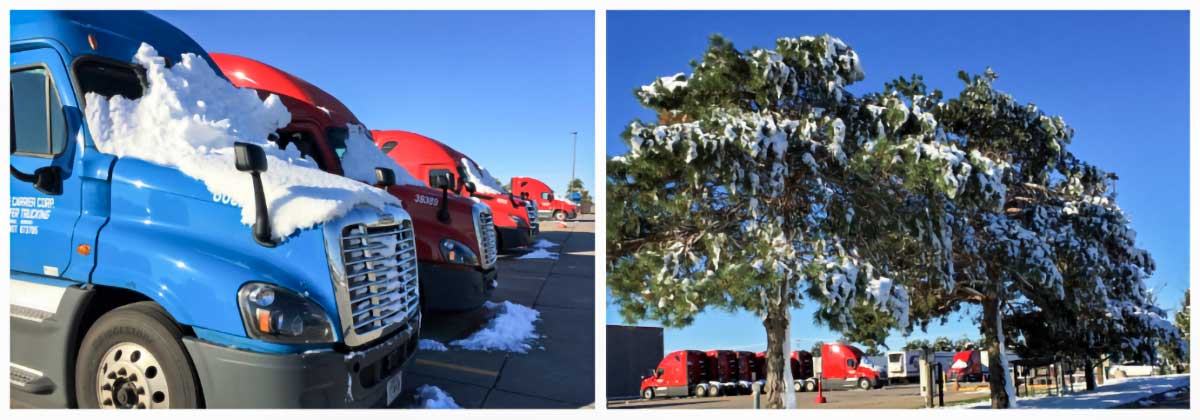With winter weather underway in parts of the country it’s time to start thinking about winter driving procedures. While I’m not writing this article to tell anyone how to drive their truck, there are certain things many of us already know and do during inclement weather but don’t really think about until we are in the thick of it. A good habit is to begin practicing them early on while weather conditions are still favorable so that when the time comes you’re already doing the right things by habit.
This 2-part series is aimed at newer drivers who have limited winter driving experience to help put them on a path to safety and success in the coming months. Part 1 covers the preparation. Part 2 focuses on winter driving tactics.
BE PREPARED
Let’s consider some things a driver should have with them before the start of winter.
- Warm clothing, including a high-visibility coat, hat/headgear and warm waterproof gloves. There’s nothing worse than wet and freezing cold hands. Have a second pair of shoes or boots in case one set gets soaked and needs to dry. Cold wet feet are miserable and can lead to conditions like trench foot or frostbite that can require medical treatment.
- WINTER grade washer fluid. Be sure to check the temperature rating of the fluid you are carrying and have in the tank. Summer fluid will freeze solid in extremely cold weather and bring your trip to an abrupt halt. If you have summer washer fluid in the tank, drain it out now and refill it with winter fluid. I carry at least 3 extra gallons on top of a full tank. Many times I have used almost all that I had on a single trip due to road salt and chemicals smearing the windshield.
- A good snow shovel. You can hang it on your load lock rack and secure it from movement with a bungee cord or piece of rope.
- A bag of snow melting salt. I pick up a 50 pound bag at the start of every winter. Not only can it help clear you a path out of a slick parking spot, but it’s also a way to get traction on a dock that has a downhill to the rear grade towards the dock. Kitty litter can also be very useful for this purpose.
- A good snow scraper with a brush to clear the windshield and other areas without getting your hands wet.
- A folding step stool (this is a year-round item). They are of great help to climb up on the steer tires if you need to clean your windshield or replace a wiper and provide a solid footing while cleaning your mirrors.
- A spare key. A secure and well-hidden key placed outside your truck could be the difference between life and death if you accidentally lock yourself out in an isolated area during extreme winter conditions. I learned this from experience, but was fortunately at a truck stop in Pennsylvania. I had just swapped into a different truck and had forgotten where I had put the key. It was night and -25 degrees with the Wind Chill. Crete required me to pay for the unlocking of the truck but I was half frozen before I got back inside.
- A window squeegee. This is another year-round recommendation. We’ve all seen *That Driver* who uses the squegees provided by the truck stop to clean off their fuel tanks after a spill—and then drops it right back in the bucket. I also avoid using the provided bucket of windshield cleaner for the same reason.
- A full set of new winter wiper blades. Having one break when out on the road can be a very bad issue if you are unable to replace it quickly.
- De-icing spray. It is a major time saver and has many uses.
- A good supply of water. Carry at least a couple of gallons as well as extra food and blankets. Every year major highway closures strand thousands of drivers, sometimes for days at a time. You may find yourself not only looking out for your own welfare but assisting another driver or motorist in need.
- Rubber slip on ice cleats for your shoes/boots. They can usually be found at Walmart or ordered online. I’ve slipped and fallen more times than I care to admit without them—and seeing my feet up in the air higher than my head never ends well.
- Carry a good supply of plastic bags. Large grocery bags or some 11-13 gallon kitchen bags with the drawstring work well. When you’re parked and have snow or ice moving in, clean your mirrors, cover them with the bags and tie them with a half knot. A couple of larger rubber bands on the door mirrors will prevent the excess bag from flapping around. When it’s time to leave remove the bags and you’ll have clean and clear mirrors. Turn on the mirror heaters as soon as you get up to ensure they are dry and ready to go.
These are a few of my thoughts for drivers to consider and use if they find the information useful. It is by no means a complete list of winter driving tips and procedures. Every driver’s experience is unique. The point is to share what we have learned with one another and to promote safe driving on our highways and byways. I would love to hear from others about additional tips that they use, and share them on my Facebook page at “Thoughts from the Road.” Until next time, keep up the hard work and stay safe my friends.



